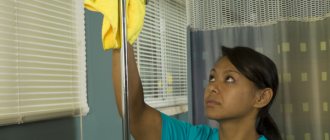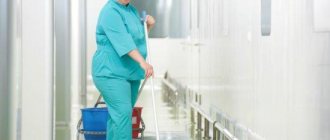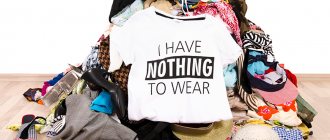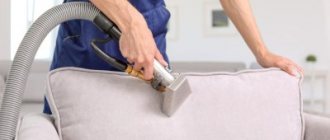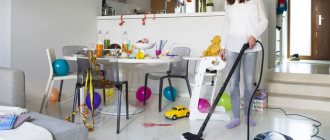Download! SanPiN: Current cleaning in health care facilities. Algorithm according to SanPiN
Click on the picture to enlarge
Click on the picture to enlarge
Health care facilities are a special type of premises in which cleanliness and order should always be at their best. In order for routine cleaning at such facilities to achieve high-quality results, it is recommended that it be carried out in accordance with current standards and sanitary rules.
Only if this condition is met will the medical institution be truly clean, which is one of the main conditions for the safety of the employees and patients themselves.
Attention! Do not forget that you should also carry out general cleaning in the health care facility. The rules for such cleaning differ from those that will be described in this article. If you are interested in the algorithm of actions for general cleaning, read this article:
Cleaning schedule: General sample
Clear organization of work is an important point in professional, high-quality cleaning, as in any other labor process.
When the performer clearly sees that he spends a clearly defined amount of time on putting a specific object in order, his efficiency and motivation will increase.
But in order to draw up a suitable schedule, it is necessary to take into account many circumstances, such as the specificity of the object, customer requirements, selection of special equipment, and the like.
For example, schedules for cleaning toilets in a kindergarten or a large shopping center will vary significantly.
Each cleaning service is divided according to the following characteristics:
- Technological. This includes collecting garbage, putting various surfaces in order, cleaning from stains, vacuum treatment, wet cleaning, disinfection, protection against aging of rooms and objects, safety during operation, etc.
- Type of object. Types are divided into objects where people live (apartments, houses, cottages), public and industrial institutions, and adjacent territories.
- Frequency. Here, services are differentiated into comprehensive initial, daily, weekly, and general cleaning.
We would like to note that a competent approach to the process depends on the correctness of the work schedule, and also simplifies the ability to control it.
Thanks to the schedule, the scope of activity of each performer is regulated, which also helps to avoid further misunderstandings.
You can coordinate your workday, your time, and the costs of performing the required type of cleaning of any room if you use a suitable schedule with specific specifications.
When inviting staff from cleaning companies to carry out work, make sure for yourself that the cleaning process is much more efficient if it is based on a predetermined schedule.
To organize your schedule, use the convenient 1c Enterprise program. Just download it from the Internet. It is good to fill out all the columns, keep detailed records, etc.
See the example in the picture below:
To enlarge the picture, click on it
You can also use this simple form to fill out the schedule:
To enlarge the picture, click on it
Another example of a graph is Mbou DOD Children's Art School named after A.N. Verstovsky:
To enlarge the picture, click on it
What are the features of cleaning in health care facilities?
What does routine cleaning in health care facilities mean?
In a medical institution, cleaning work includes:
- washing windows, floors and doors;
- mandatory disinfection of surfaces;
- cleaning all furniture from dirt and dust.
But it is necessary to take into account: as part of sanitary procedures, you can use only those chemicals and disinfectants that are approved for use by regulatory authorities.
The list of necessary equipment that must be in a healthcare facility deserves special attention:
- disinfectants;
- detergent compositions;
- buckets;
- mops ( see which ones are best for cleaning );
- cleaning materials (for example, technical wipes);
- containers.
By the way, the latter, along with buckets and mops, usually differ depending on what they are used for: windows, floors, work surfaces or furniture.
Watch the video: Requirements for the cleaning system in a medical organization
Wet cleaning of the office
An algorithm for wet cleaning of the treatment room has been developed. It is preferable to perform it using the so-called mop technique, which cannot cause harm. A mop is a tool prepared in advance, with which wet sanitation is carried out. The mop method has the following features:
- For each individual office in which tidying will take place, it is necessary to prepare the required number of napkins, mops and other equipment.
- The equipment cannot contradict the sanitation requirements of a particular medical office.
- Inventory must be marked with stickers of different colors according to the type of work or room. This helps make the tool selection process much easier.
- All prepared mops and napkins must be treated in advance with a disinfectant solution (0.05 ml of the drug for each napkin, 0.25 ml for each mop).
- The equipment that has been prepared is placed on a special cart for sanitation.
The algorithm for routine cleaning of the treatment room involves washing using equipment and supplies that are specially designed for use in medical institutions. To create it, materials are used that ensure the comfort of the procedure and a long period of operation even with active daily use.
Napkins and mops are also allowed to be used repeatedly, but only if they are systematically washed and disinfected. The final cleaning algorithm for the treatment room is also based on this method. The Mop method is a selection technique. But it makes it possible not only to guarantee compliance with sanitary epidemiological requirements in medical institutions, but also leads to a reduction in the burden on medical personnel. It reduces the risk of developing musculoskeletal diseases and other occupational pathologies.
In addition, the “non-bucket” method of wet cleaning of the treatment room allows a medical institution to significantly reduce costs associated with the purchase of new equipment and the purchase of consumables. By following the rules for cleaning the treatment room, you can achieve ideal sterility of the room, equipment, and instruments.
The main algorithm for carrying out routine cleaning in health care facilities
What stages are the current cleaning that is carried out in a medical facility divided into? There is a special algorithm that is approved by SanPin.
The sequence will be like this:
- The cleaner, strictly in overalls, must move away all objects that are movable. This applies primarily to furniture. After it has been moved away from the walls, you need to thoroughly wash all surfaces using detergents.
- Wash off chemical residues with clean water.
- Using disinfectant solutions ( buy these! ), surfaces are thoroughly treated. At this stage, you cannot rush, since the composition used requires a certain time for the high-quality and complete destruction of pathogenic microorganisms.
- The next step is to change aprons and gloves. Next, the cleaner must thoroughly rinse off all residual disinfectants from the surfaces being treated with clean water. After this they are wiped dry.
- Now the floor is being washed.
- All premises must be disinfected. Ultraviolet light is used for this.
The current cleaning of the health care facility is completed in accordance with the standards by cleaning all equipment. The devices will need to be washed and dried, after which they are sent to specially designated rooms for storage. All work clothes go to the laundry.
Concept of current disinfection
The term “current disinfection” refers to the cleansing of the area where the infection has spread. The purpose of this procedure is to destroy the source of the disease (causative agent).
Indications for the implementation of measures are:
- the patient’s presence in the source of infection until hospitalization;
- outpatient therapy of an infectious patient;
- in a situation where the sick person releases bacteria into the external environment (coughing, saliva, sneezing) until complete recovery;
- stay in the apartment of a convalescent (patient in the recovery stage) until deregistration at the tuberculosis dispensary.
Disinfection is organized by a specially trained medical worker who has identified an infectious patient, as well as sanitary and epidemiological control services. The role of the medical staff is to convey to the patient how to daily disinfect the place of residence.
There are several groups of measures for ongoing disinfection:
- sanitary and hygienic works;
- application of measures to disinfect environmental objects and physiological secretions of the patient.
Current disinfection is carried out by relatives living with the patient.
Who is leading and why?
The employer has the obligation to comply with sanitary and epidemiological requirements. One of them is keeping cleaning logs to help organize and monitor this work. There are several of them:
- accounting for current cleaning;
- accounting for general cleaning;
- disinfection.
The management of medical, educational organizations, catering establishments and other public places are required to maintain these documents by sanitary and epidemiological requirements. A separate SanPiN has been developed for each area of activity, which contains requirements on the frequency and methods of cleaning, including general cleaning.
In addition, the sanitary and epidemiological rules SP 3.1.3597-20, approved by the Decree of the Chief Sanitary Doctor No. 15 of May 22, 2020, and recommendations of Rospotrebnadzor No. 02/3853-2020-27 of March 10, 2020, No. 02/6338-2020-15 dated 04/07/2020, all organizations and entrepreneurs are required to carry out special measures to prevent the spread of coronavirus. These include additional methods and modes of sanitation and disinfection of not only objects, but also air.
Recommendations from Rospotrebnadzor dated September 29, 2020 require that enterprises be disinfected every 2 hours and have a supply of disinfectants for at least 5 days. A disinfection log is maintained to confirm compliance with these measures.
It is important that the sample journal for treating premises with disinfectants against coronavirus, developed at the enterprise, takes into account all methodological recommendations
Read more: explanation from Rospotrebnadzor on carrying out disinfection measures in office premises, along with instructions on the procedure for carrying out disinfection measures in order to prevent a new coronavirus infection in office premises.
Profile SanPiN may oblige you to maintain additional accounting books. For example, this is done by SanPiN 2.1.3.2630-10 for medical organizations.
A designated person, whose data is indicated in the document, is responsible for maintenance. The responsibilities of this employee are specified in the job description. For violations committed, both this employee and the head of the enterprise are brought to administrative and other types of liability.
How to find out about restrictions and other measures due to coronavirus
ConsultantPlus has collected all the current rules in one review: what is prohibited and what is allowed, whether it is mandatory to wear masks, what support measures are still in effect, and what monetary payments individuals and organizations can still receive. Convenient to keep track of changes. Free access for 2 days.
Recommendations from Rospotrebnadzor
The most detailed general recommendations are contained in the recommendations of Rospotrebnadzor, given in Letter No. 02/3853-2020-27 dated March 10, 2020. Employers are recommended:
Provide an antiseptic at the entrance and monitor its use by employees; Perform continuous temperature checks using a non-contact method; carry out high-quality cleaning, pay special attention to pens, eating rooms, toilets, etc. every two hours; how often general cleaning of premises is carried out is established by recommendations for enterprises in specific areas of activity
Typically, such cleaning is mandatory before the start of an activity, and then the frequency is not provided. There are exceptions: for example, in paid wards in medical organizations, general cleaning must be carried out at least once a month; ventilate the rooms every two hours; carry out air disinfection; use disposable tableware for employee meals, which is then destroyed; reusable dishes should be carefully processed in specialized machines; allocate a separate room for meals, prohibit dining on site; clean it every day using disinfectants.
Since Rospotrebnadzor Letter No. 02/3853-2020-27 dated March 10, 2020 was issued quite a long time ago and does not contain mandatory standards, entrepreneurs need to be guided by the joint venture and regional regulations.
General processing rules
General cleaning of the dental office is performed using the “two buckets” technique. For this:
- Take a couple of containers. The first is filled with a disinfectant solution, the second - with tap water.
- The rag is soaked in the first container. After sanitization, 2 m2 is rinsed.
- The contents of 1 bucket are renewed every 60 m2 of washed surface.
- The contents of bucket 2 are updated as they become dirty.
The procedure for general cleaning in dentistry:
- First of all, the room is cleaned with the usual cleaning compositions to wash off mechanical and other contaminants for the most effective effect of the disinfectants on the surfaces being treated.
- Wipe all surfaces with a cloth well soaked in a disinfectant solution.
- Turn on ultraviolet devices (exposure 60 minutes).
- Wash with water (boiled or distilled) with a clean cloth. At the same time, health workers change into new overalls and shoes.
- A bactericidal disinfectant is launched.
If the disinfectant has a detergent ingredient, then the process of disinfection and washing off dirt can be combined. This will reduce sanitation time.
Quality control and recording of general cleaning
The head nurse or other responsible person monitors the quality of general cleaning. Every month, the head nurse of the department draws up a general cleaning schedule for the structural unit. She schedules planned cleaning dates before the end of the month.
The general cleaning schedule should reflect the planned and actual dates of general cleaning, the name of disinfectants and the concentration of working solutions. This will allow you to control the timing and disinfection regime during general cleaning. The head of the medical organization or the commission for the prevention of nosocomial infections can add additional information to the schedule.
For the operating room, dressing rooms, treatment rooms, manipulation rooms and other rooms with special operating conditions, a cleaning log is kept (clause 4.31 of Chapter III of SanPiN 2.1.3.2630-10).
Medical organizations develop a schedule and journal independently in the form of a local document.
The cleaning algorithm is developed by the responsible employee on the orders of the head of the organization. The document includes a description of equipment, chemicals, personal protective equipment, a list of types and scope of work, a description of the cleaning method and technique. Requirements for the conditions of cleaning work, safety and the content of regulatory and technical documents for specific types of professional cleaning are formulated in GOST R 51870-2014.
Conducting general cleaning is an important aspect of any medical facility. All medical personnel need to remember this and approach the process with a high degree of responsibility.
Frequency of general cleaning
As planned, general cleaning is carried out according to a schedule approved by the head of the structural unit. The frequency of cleaning depends on the cleanliness class of the room. In rooms of cleanliness class A and B, general cleaning is carried out once a week, in the rest - once a month (clauses 11.7–11.8 of Chapter I of SanPiN 2.1.3.2630-10).
Each cleanliness class has its own requirements for operating mode and level of air and surface cleanliness. They are presented in the table “Permissible levels of bacterial contamination of indoor air”
| Cleanliness class | The name of a room | Operating mode | Risk to the patient |
| A | Operating rooms, maternity rooms, aseptic boxes for hematology and burn patients, wards for premature babies, aseptic block of pharmacies, sterilization room (clean half), boxes for bacteriological laboratories | Aseptic | High |
| B | Treatment rooms, dressing rooms, preoperative rooms, intensive care wards and rooms, children's wards, rooms for collecting and pasteurizing breast milk, assistant and packaging pharmacies, premises of bacteriological and clinical laboratories intended for research | Special | Average |
| IN | Surgical wards, corridors adjacent to operating rooms, maternity rooms, examination rooms, boxes and wards of infectious diseases departments, residents' rooms, material rooms, clean linen storage rooms | Ordinary | Short |
| G | Corridors and premises of administrative buildings, flights of stairs of medical and diagnostic buildings, sanitary rooms, toilets, premises for temporary storage of dirty linen and temporary storage of waste |
As a one-time event, general cleaning is carried out throughout the entire facility or in individual rooms during final disinfection, as well as for sanitary and hygienic indications in cases of unsatisfactory condition of the premises and in case of unsatisfactory results of microbial contamination of the external environment, after reconstruction, completion of current or major repairs, for epidemiological indications (clauses 1.4–1.5 of chapter II of SanPiN 2.1.3.2630-10).
Final provisions
In conclusion, I would like to remind you once again that the sphere of medical services is a special category of activity, which is quite logically subject to the most stringent sanitary requirements and the implementation of which is monitored regularly by the relevant supervisory authorities. And sanitary requirements are not developed and approved out of nowhere; failure to comply with them several times increases the risk of patients contracting dangerous infections. The better and more reliable each medical institution is equipped, the safer and more successful the treatment of each patient will be.
Based on the data from Reviews of law enforcement practice of control and supervisory activities of the Ministry of Defense's implementation of established sanitary requirements for heating, microclimate, ventilation and air environment, carried out by Rospotrebnadzor and its territorial bodies, as well as the Federal Medical and Biological Agency, the main violations identified are the following:
- not all mechanical supply and exhaust ventilation systems are certified; the frequency of cleaning and disinfection of ventilation systems, replacement of high-purity filters, and cleaning of ventilation chambers is violated;
- unregulated air conditioning and split systems are used;
- microclimate parameters and indicators of microbial contamination of the air are not monitored at least once every 6 months;
- The ventilation system does not work / does not work well;
- annual cleaning and disinfection of mechanical supply and exhaust ventilation systems, monthly cleaning of ventilation chambers and air intake chambers have not been carried out;
- medical staff washes, dries and irons medical clothing in clinical departments, operating rooms, and intensive care units, which, in turn, violates the permissible microclimate parameters;
- in the operating room, intensive care unit, diagnostic ward of the emergency department with an intensive care unit there is no independent ventilation system.
As for FAPs and outpatient clinics, the technical condition of most of them leaves much to be desired. Currently in Russia, only half of such medical institutions meet current sanitary requirements; many first aid stations and outpatient clinics do not have central heating, water supply, or sewerage.
In any case, responsibility for compliance with sanitary rules and regulations lies with the Ministry of Defense, their managers and other officials
At the same time, it is important to remember that in cases of group infectious and non-infectious diseases, emergency situations in the operation of heat supply systems, ventilation, water supply, sanitation, technological equipment, which create a threat of the emergence and spread of infectious diseases and poisonings, the heads of the Ministry of Defense bear responsibility for organizing operational notifications to territorial bodies authorized to carry out state sanitary and epidemiological supervision, and for ensuring the implementation of the necessary set of preventive and (or) anti-epidemic measures
Effective cleaning of premises of medical organizations
What needs to be done to ensure that cleaning the premises of medical organizations is effective?
Firstly, ensure the integrity of the hygienic coating of the surfaces being treated. That is, the surfaces of walls, floors, ceilings, furniture, equipment, heating devices, etc. should not have chips, crevices, cracks, other mechanical damage, signs of corrosion, etc. Their surface must be smooth, preventing the adsorption of dust (clause 4.2 of section 1 of SanPiN 2.1.3.2630-10).
Secondly, the covering of floors, walls, ceilings, furniture, equipment, heating devices, etc. must be made of materials that are resistant to treatment with detergents and disinfectants (clause 4.2 of section 1 of SanPiN 2.1.3.2630-10).
Thirdly, it is necessary to place furniture and equipment in the premises in such a way that all surfaces are easily accessible during cleaning (clauses 6.2 and 8.2 of section 1 of SanPiN 2.1.3.2630-10).
Fourthly, choose the right detergents and disinfectants, ensure their proper storage and preparation of working solutions (clauses 11.1–11.4 of section 1 of SanPiN 2.1.3.2630-10).
Fifthly, allocate a sufficient amount of cleaning equipment, ensure its marking and storage (clauses 11.5, 11.11 of section 1 of SanPiN 2.1.3.2630-10).
Sixth, train personnel in the technique and frequency of routine and general cleaning (clause 11.1 of section 1 of SanPiN 2.1.3.2630-10).
Cleanliness in the apartment - order in the head
In addition, the large-scale process of cleaning a living space also has a psychological background. That is why it is also the main way to relieve yourself of the burdens of everyday life. When carrying out such cleaning, it is customary to get rid of unnecessary things with which we litter rooms and balconies during the winter.
Do you know the feeling of heaviness when you look at the accumulated rubbish that you are about to throw out, but “you can’t get around to it”? From a psychological point of view, a person associates old and unnecessary things as their own problems. That is why there is no more pleasant feeling than getting rid of ballast and enjoying the freed-up space where just some time ago there were piles of garbage. Total psychological relief is another criterion for why spring cleaning is called that.
